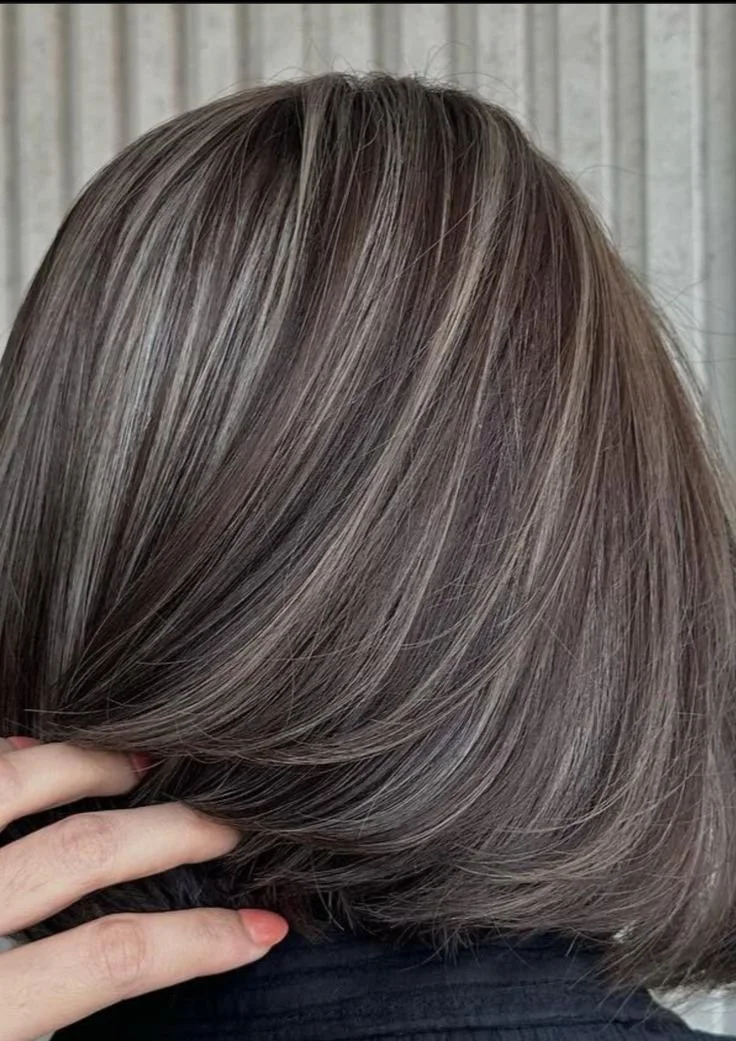Blending Grey Hair with Highlights and Lowlights:
Blending grey hair with highlights and lowlights has become one of the most refined ways to embrace natural silver tones while maintaining dimension and vibrancy. Blending grey hair with highlights and lowlights offers a balanced approach that softens the line of regrowth and enhances the hair’s natural movement.
Understanding the Art of Grey Blending
Grey blending is a method that incorporates lighter and darker tones to merge natural greys with the rest of the hair. Rather than covering greys completely, the goal is to integrate them into a customized palette that complements skin tone and hair texture. By using a combination of highlights and lowlights, stylists can create softness, break up harsh lines, and design a color pattern that looks natural and effortless.
Why Use Both Highlights and Lowlights?
Highlights illuminate sections of the hair, adding brightness and creating a youthful glow. Lowlights add depth and shadow, preventing the hair from looking flat or overly monotone. When these two techniques are used together, they produce a multi-dimensional effect that mimics naturally sun-kissed hair. This balance is particularly effective for grey blending, as it masks the contrast between pigmented strands and silver ones.
Benefits of a Multi-Dimensional Grey Blend
A well-executed blend offers numerous advantages:
Soft regrowth: With the right balance of tones, the transitional line as hair grows out becomes subtle and less noticeable.
Natural texture enhancement: Grey hair often has its own texture; highlights and lowlights accentuate this in a flattering way.
Low-maintenance beauty: Instead of frequent root touch-ups, clients enjoy a more forgiving grow-out period.
Customized color: Every head of hair has its own pattern of grey, which makes blending a versatile technique adaptable to all needs.
Where the Technique Works Best
Blending works beautifully on medium to long lengths where dimension can be fully expressed, but it is also effective on short haircuts. For pixies, bobs, or layered cuts, strategically placed highlights and lowlights add movement and shape. Stylists often choose gentle foil placements or freehand painting to tailor the design to the individual.
The Role of Tone Selection
Choosing the correct tones is critical. Warm highlights such as honey or beige create a soft glow, while cool tones like ash or pearl help neutralize warmth and blend naturally with silver strands. Lowlights may range from smoky taupe to darker espresso, depending on the desired drama and the client’s base color.
A skilled colorist considers skin undertones, eye color, natural grey patterns, and lifestyle needs. The result is a personalized blend that feels harmonious and modern.
Grey Blending at The Salon Project by Joel Warren
For those seeking a sophisticated, natural-looking grey blend, The Salon Project by Joel Warren is known for its meticulous attention to detail and its mastery of custom color techniques. The salon’s approach focuses on enhancing each client’s individual beauty rather than following a one-size-fits-all formula. Their color experts assess the texture and distribution of grey, then create a highlight–lowlight strategy that produces a graceful transition between shades.
What distinguishes The Salon Project is the precision in placement and the salon’s signature philosophy of achieving elegance through subtlety. Every blend is designed to evolve gracefully over time, allowing clients to enjoy long-lasting, low-maintenance beauty. This makes it an ideal destination for anyone seeking a transformative yet natural color experience.
Techniques Used for Seamless Blending
Professional colorists rely on a variety of methods to achieve smooth, multi-dimensional blending:
1. Foil Highlights
Foil placement offers control over brightness levels and allows stylists to lift certain strands precisely. This method ensures consistency and helps create a polished finish.
2. Balayage
Balayage is perfect for clients wanting a soft, lived-in look. Painted highlights gently merge with natural grey roots, giving a sunlit effect that lasts for months.
3. Reverse Lowlights
When too much brightness exists, reverse lowlights reintroduce depth. This method is essential for balancing previously over-lightened hair and promoting dimension.
4. Micro-Highlights
Tiny ribbons of light subtly break up strong grey stripes without overwhelming the base. This delicate method is ideal for those transitioning from full coverage dye to grey blending.
Choosing the Right Maintenance Routine
Although grey-blending is low maintenance, proper care enhances longevity and keeps color fresh:
Purple shampoo: Helps neutralize unwanted yellow tones.
Hydrating masks: Grey hair may be coarse or dry, and moisture restores softness.
Gloss treatments: Add shine and refine tone between salon visits.
Heat protection: Essential for preserving color vibrancy and preventing dullness.
Visiting a trusted salon like The Salon Project by Joel Warren ensures that each maintenance step is tailored to your unique needs.
Transitioning to Natural Grey with Confidence
For clients who want to embrace their natural grey gradually, blending with highlights and lowlights is an ideal transition strategy. Rather than making an abrupt change, the blend allows for a smooth emotional and aesthetic journey. The aim is not to hide the grey, but to celebrate and elevate it.
Stylists can slowly adjust the ratio of highlights to lowlights, reducing reliance on pigmented color over time. This creates a graceful evolution that aligns with personal comfort and style goals.
Final Thoughts
Blending grey hair with highlights and lowlights is a sophisticated and modern approach to celebrating natural silver tones. It offers dimension, softness, and effortless beauty while reducing maintenance demands. When executed by expert colorists—particularly those at The Salon Project by Joel Warren—the result is a harmonious, luminous hair color that enhances confidence and complements individuality.
Whether you are beginning your grey journey or seeking a polished update, this method provides a versatile and elegant solution for every stage.




